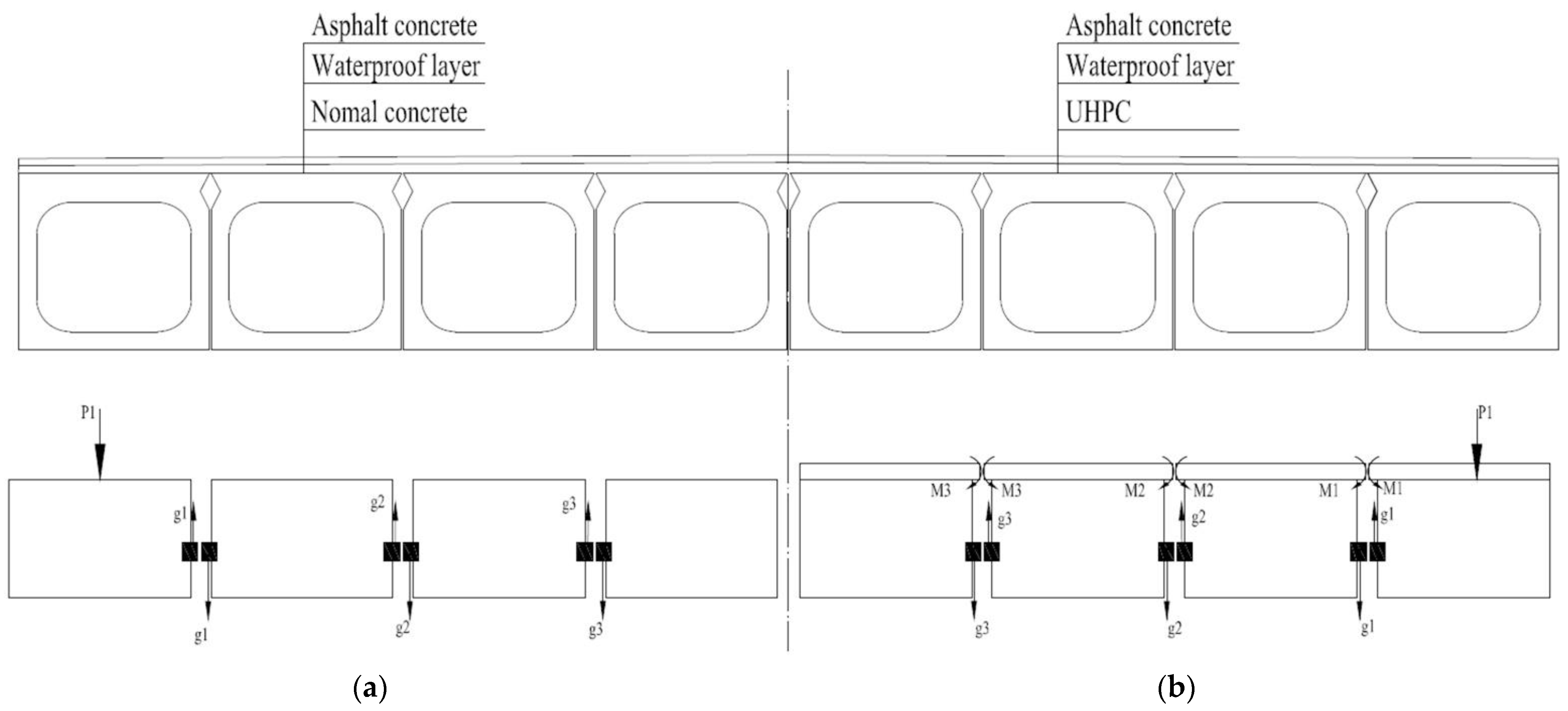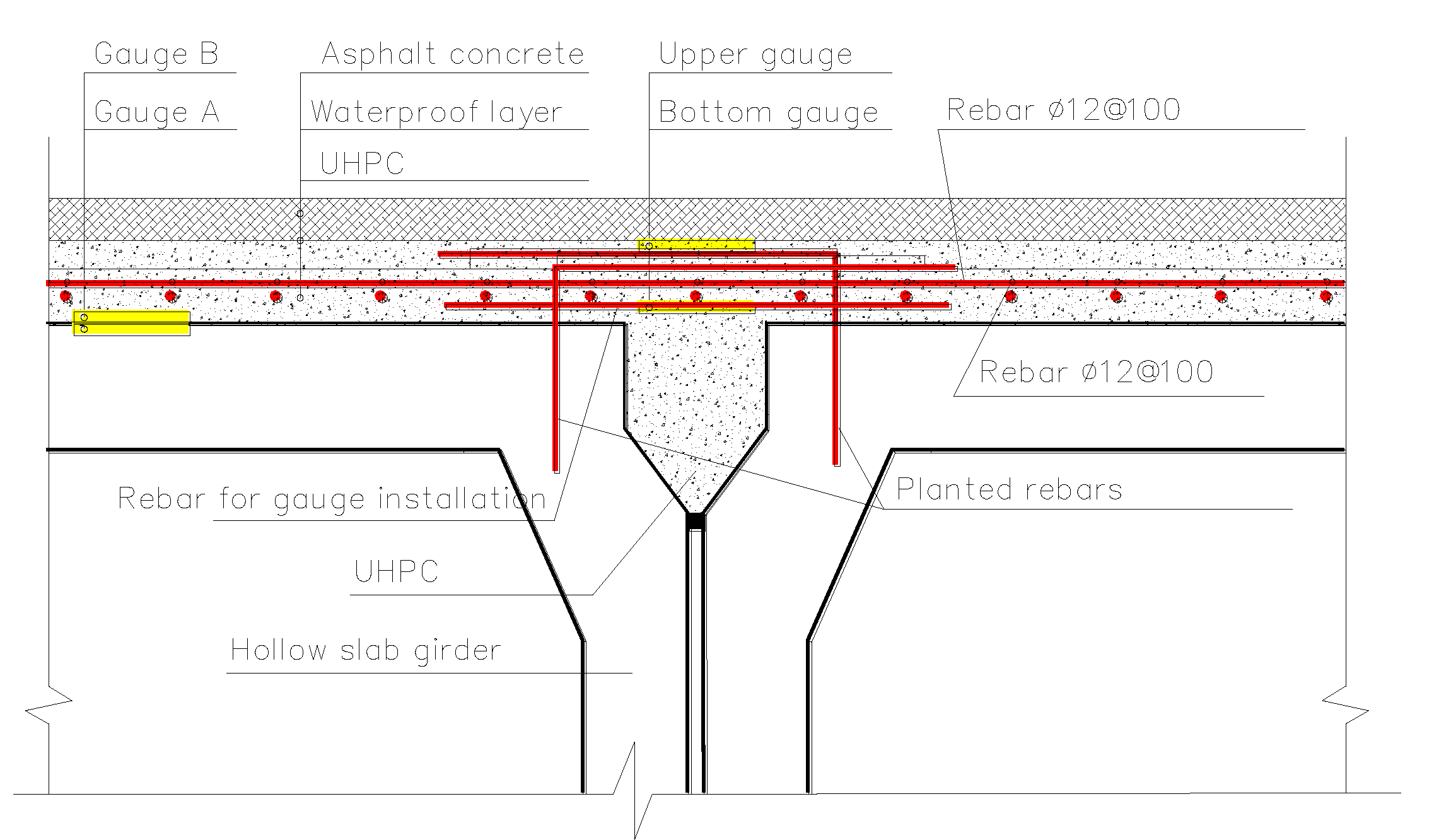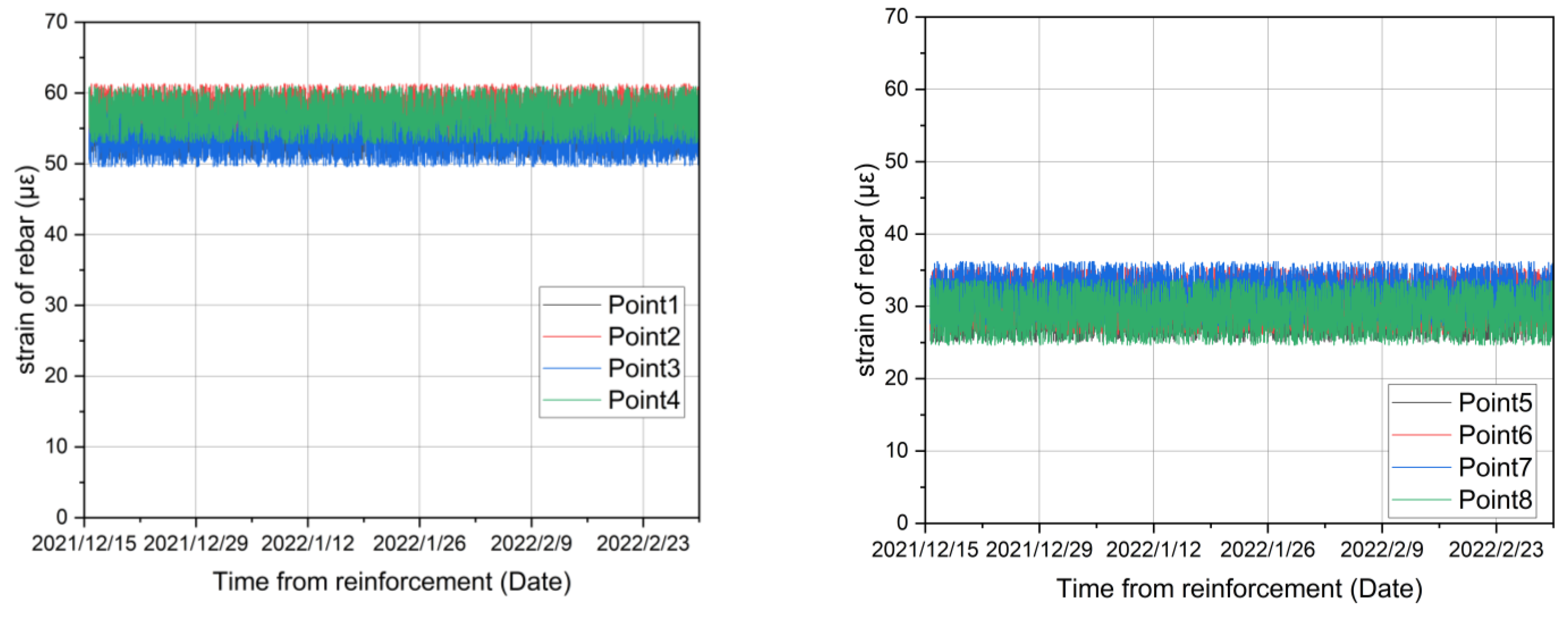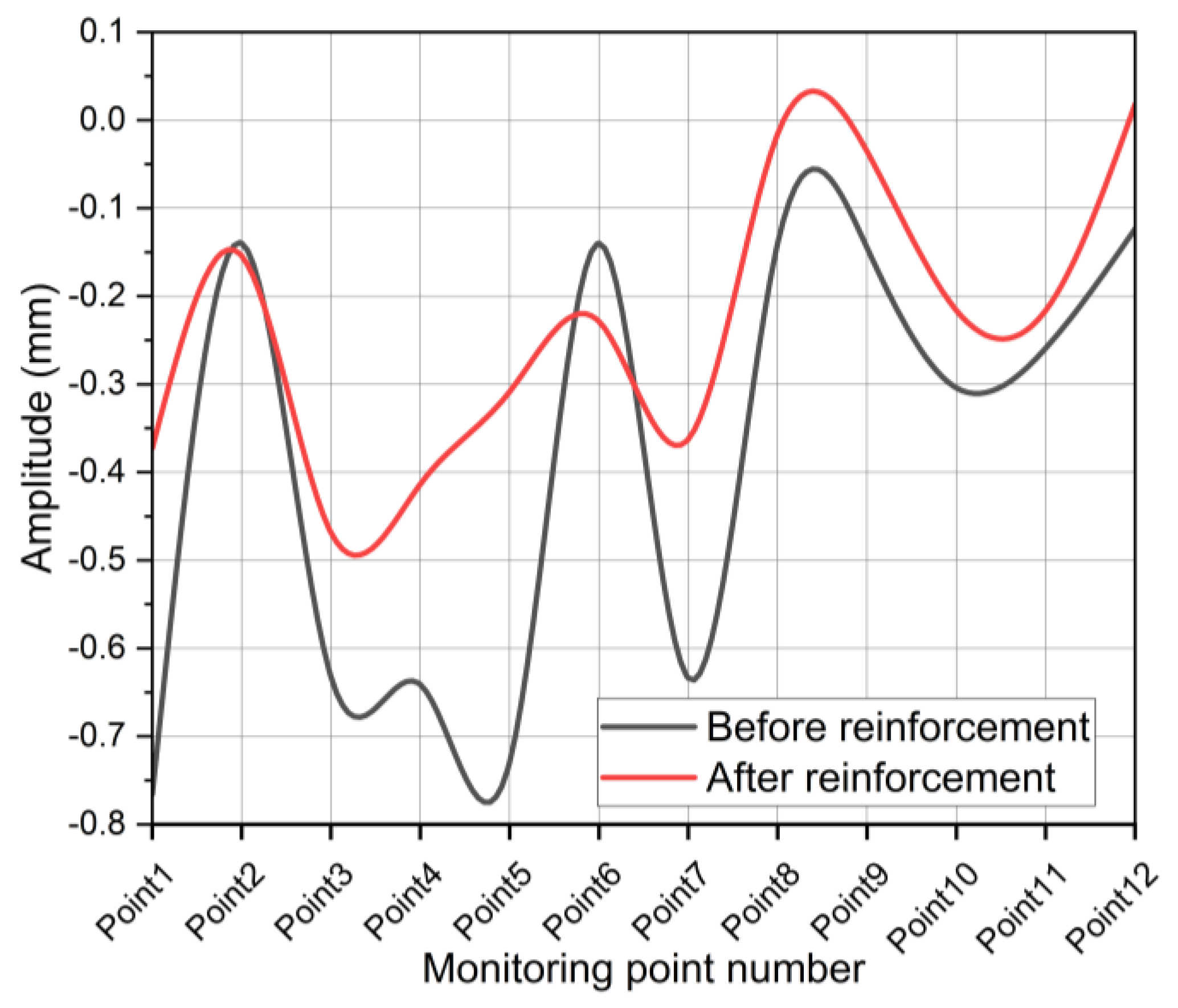Study on the Structural Performance of UHPC Pavement and Hinge Joint Reinforcement for Hollow Slab Girder Bridges
Abstract
:1. Introduction
2. Background Engineering
3. Structural Method of Reinforcement and Construction Stages
3.1. Theoretical Basis of Hollow Girder Reinforcement
3.2. Reinforcement Method
- (1)
- The previous pavement layer is completely removed and replaced with UHPC and stone matrix asphalt (SMA).
- (2)
- Partial removal of the previous pavement, which is followed by the addition of a thin layer of UHPC and SMA is added.
3.3. Construction Stages
- (1)
- Traffic Closure
- (2)
- Removal of the top pavement and hinged concrete
- (3)
- Reinforcing bars
- (4)
- Laying rebar in the pavement layer
- (5)
- The surface of the slab girder was cleaned completely and the debris and rubbish generated by the planting rebar were removed (Figure 6b).
- (6)
- UHPC construction of the pavement layer
- (7)
- Adhesive layer structure
- (8)
- Curing
- (9)
- Bridge deck asphalt concrete paving construction
- (10)
- Clean up the site and open it up to traffic.
4. Verification and Monitoring of the Reinforcement Effect
4.1. Deflection Monitoring
4.2. Strain Monitoring of Hinge Joint
4.3. Adhesion between UHPC and the Girder
5. Data and Analysis
5.1. Strain Characteristics after Reinforcement
5.2. Changes in Structural Stiffness after Reinforcement
6. Conclusions
- (1)
- The designed bridge deck pavement adopted 8 cm thick UHPC and 4 cm modified asphalt concrete pavement, the transverse load-bearing performance of the beam slab was enhanced, and the overall bearing capacity was improved. Based on the conclusions of other researchers and the performance of UHPC, the UHPC thickness can be optimized.
- (2)
- Several researchers have already proved that the effect of planting reinforcement on the joint surface between the UHPC and the main girder is significant. This allows the original concrete layer and the UHPC layer to be more closely connected. Rebars planted at the hinge joint with UHPC greatly improve the transmission capacity of the transverse force between the slab girders.
- (3)
- In terms of the performance of the bond between the UHPC and the bridge, according to the stress analysis of the monitored rebar and UHPC, the change in the stress on the hinge joint was mainly tensile at less than 55 με and the amplitude was less than 10 με. Judging from the similarity of the strains of the two types of gauges, the rebar and the UHPC maintain a good synergistic effect.; The shear deflection of the hinged joint due to the change in the beam was not obvious, which proves that the UHPC pavement had a positive impact.
- (4)
- Monitoring the amplitude of the reinforced bridge deck proved that the overall performance of the bridge reinforced with UHPC was significantly improved. The minimum and maximum amplitudes after reinforcement (minimum −1.5~−1.0 mm, maximum 0.75~1.25 mm) were reduced by half compared to before reinforcement (minimum: −3.0~−2.0 mm, maximum 2.0~3.0 mm).
- (5)
- The improvement in the flatness of the bridge surface has a positive effect on reducing bridge vibration. The resistance to the deformation of the UHPC pavement layer was relatively excellent, and the bond between the UHPC and girders was also very strong without delamination. It should be noted that the bridge pavement and hinge joints were repaired at the same time, which affected their respective contributions to a certain extent.
- (6)
- Since the reinforced pavement with reinforced hinges already increased the mechanical performance and affected the load distribution of each girder, the new theoretical calculation method for the live-load distribution factor should be restudied. The monitoring data from real bridges can play an auxiliary role in static load testing to verify the theoretical method.
Author Contributions
Funding
Institutional Review Board Statement
Informed Consent Statement
Data Availability Statement
Conflicts of Interest
References
- Miyamoto, A.; Kiviluoma, R.; Yabe, A. Frontier of continuous structural health monitoring system for short & medium span bridges and condition assessment. Front. Struct. Civ. Eng. 2019, 13, 569–604. [Google Scholar] [CrossRef]
- Zhang, B.; Zhu, D.; Xu, J.-W.; Tian, H. Overall Situation and Typical Diseases of Medium and Small Span Concrete Bridges in Zhejiang Province. J. Chongqing Jiaotong Univ. (Nat. Sci.) 2013, 32, 742–745. [Google Scholar]
- Huang, P.M.; Wang, J.F.; Han, W.S.; Yuan, Y.G. Study on impact factors of small- and medium-span bridges under the special-purpose vehicle load. Structures 2022, 43, 606–620. [Google Scholar] [CrossRef]
- Gao, Q.F.; Wu, B.; Li, J.; Cui, K.M.; Xu, C. Investigation of Traffic Loading Effects for Different Codes on Medium- and Small-Span Girder Bridges in China. Adv. Civ. Eng. 2020, 2020, 8851981. [Google Scholar] [CrossRef]
- Szafranski, M. Dynamics of the small-span railway bridge under moving loads. Matec. Web Conf. 2019, 262, 10014. [Google Scholar] [CrossRef]
- Looney, T.; Volz, J.; Floyd, R. Behavior of a 3-Span Continuous Bridge Before and After Continuity Joint Replacement Using Ultra-High-Performance Concrete. J. Perform. Constr. Fac. 2021, 35, 04021087. [Google Scholar] [CrossRef]
- Lu, Z.; Feng, Z.G.; Yao, D.D.; Li, X.J.; Jiao, X.L.; Zheng, K.X. Bonding performance between ultra-high performance concrete and asphalt pavement layer. Constr. Build. Mater. 2021, 312, 125375. [Google Scholar] [CrossRef]
- Shemirani, A.B. Experimental and numerical studies of concrete bridge decks using ultra high-performance concrete and reinforced concrete. Comput. Concr. 2022, 29, 407–418. [Google Scholar]
- Huang, Y.; Chen, S.M.; Gu, P. Interface stress analysis and fatigue design method of steel-ultra high performance concrete composite bridge deck. Structures 2022, 38, 1453–1464. [Google Scholar] [CrossRef]
- Yang, J.; Hou, P.; Pan, Y.; Zhang, H.L.; Yang, C.Q.; Hong, W.; Li, K.F. Shear behaviors of hollow slab beam bridges strengthened with high-performance self-consolidating cementitious composites. Eng. Struct. 2021, 242, 112613. [Google Scholar] [CrossRef]
- Chen, S.; Visintin, P.; Oehlers, D.J. Bond between very-high and ultra-high performance fibre reinforced concrete and profiled deck sheeting. J. Build. Eng. 2022, 52, 104426. [Google Scholar] [CrossRef]
- Harris, D.K.; Sarkar, J.; Ahlborn, T.M. Characterization of Interface Bond of Ultra-High-Performance Concrete Bridge Deck Overlays. Transp. Res. Rec. 2011, 2240, 40–49. [Google Scholar] [CrossRef]
- Bruehwiler, E. Renewal of reinforced concrete bridges by means of UHPFRC. Beton Stahlbetonbau 2022, 117, 720–732. [Google Scholar] [CrossRef]
- Bertola, N.; Schiltz, P.; Denarie, E.; Bruehwiler, E. A Review of the Use of UHPFRC in Bridge Rehabilitation and New Construction in Switzerland. Front. Built Environ. 2021, 7, 769686. [Google Scholar] [CrossRef]
- Valikhani, A.; Jahromi, A.J.; Mantawy, I.M.; Azizinamini, A. Experimental evaluation of concrete-to-UHPC bond strength with correlation to surface roughness for repair application. Constr. Build. Mater. 2020, 238, 117753. [Google Scholar] [CrossRef]
- Liu, C.; Ji, H.; Wang, J.; Luo, P. The new strengthening method of hollow slab girder bridges by uhpc. In Symposium on Ultra-High Performance Fibre-Reinforced Concrete: Designing and Building with UHPFRC: New Large-Scale Implementations, Recent Technical Advances, Experience and Standards; Toutlemonde, F., Resplendino, J., Eds.; RILEM Publications SARL: Montpellier, France, 2017; pp. 675–682. [Google Scholar]
- Zhang, S.; Du, S.; Ang, Y.; Lu, Z. Study on performance of prestressed concrete hollow slab beams reinforced by grouting with ultra-high performance concrete. Case Stud. Constr. Mater. 2021, 15, e00583. [Google Scholar] [CrossRef]
- Muzenski, S.; Haber, Z.B.; Graybeal, B. Interface Shear of Ultra-High-Performance Concrete. Aci. Struct. J. 2022, 119, 267–280. [Google Scholar] [CrossRef]
- Zhang, Y.; Wu, J.; Shao, X.; Hou, C. Experiment on interfacial shear properties between ultra-high performance concrete and normal strength concrete. China Civ. Eng. J. 2021, 54, 81–89. [Google Scholar]
- De Domenico, D.; Messina, D.; Recupero, A. Quality control and safety assessment of prestressed concrete bridge decks through combined field tests and numerical simulation. Structures 2022, 39, 1135–1157. [Google Scholar] [CrossRef]
- Guo, J.; Xu, F.; Kang, L.; Li, G.; Liu, F.; Jin, Z. Lateral Distribution Calculation and Bearing CapacityAnalysis of Hollow Slab Girder Bridge Considering Integral Layer. Struct. Eng. 2021, 37, 194–199. [Google Scholar] [CrossRef]
- Sun, H.F.; Wu, Z.G.; Kang, A.H.; Gu, W.; Shen, Q.; Zhang, R.J. Research on Damage of Hinge Joint of Concrete Hollow Slab Beam. J. Henan Univ. Sci. Technol. (Nat. Sci.) 2021, 42, 57–63. [Google Scholar] [CrossRef]
- Ding, Y.; Wang, X.D.; Shi, M.S.; Lu, P.Z.; Li, D.G. Influence of Hinge Joint Damage on Transverse Force Transfer of Hollow Slab Girder Bridge. China Munic. Eng. 2021, 218, 96–99. [Google Scholar] [CrossRef]
- Orta, L.; Bartlett, F.M. Sensitivity analysis of restrained shrinkage stresses of concrete deck overlays. Eng. Struct. 2020, 210, 110396. [Google Scholar] [CrossRef]
- Zhang, H.; Zhang, Z.X.; Gao, P.W.; Cui, L.; Pan, Y.Q.; Li, K. Performance of steel bridge deck pavement structure with ultra high performance concrete based on resin bonding. Front. Struct. Civ. Eng. 2021, 15, 895–904. [Google Scholar] [CrossRef]















| Item | Test Code | Performance Index | |
|---|---|---|---|
| Requirements | Measured Value | ||
| Initial slump expansion/mm | GB/T50080 | 600–700 | 655 |
| 1 h slump expansion/mm | GB/T50080 | 550–650 | 637 |
| Compressive strength/MPa | GB/T31387 | ≥120 | 133.6 |
| Tensile strength of elastic section/MPa | Swiss SIA2052 | ≥7 | 10.1 |
| Ultimate tensile strength/MPa | Swiss SIA2052 | ≥8 | 13.9 |
| Ultimate tensile strain/% | Swiss SIA2052 | ≥0.2 | 0.45 |
| Ultimate tensile strength/tensile strength of elastic section | Swiss SIA2052 | ≥1.1 | 1.38 |
| Flexural tensile strength/MPa | GB/T31387 | ≥22 | 26.1 |
| Shrinkage (28 d) | GB/T50082 | <250 | 136 |
| Measuring Point | Maximum Amplitude | Minimum Amplitude | Average Amplitude | |||
|---|---|---|---|---|---|---|
| Before Reinforcement | After Reinforcement | Before Reinforcement | After Reinforcement | Before Reinforcement | After Reinforcement | |
| 1 | 2.204 | 1.047 | −4.502 | −1.155 | −0.766 | −0.373 |
| 2 | 2.822 | 1.123 | −2.830 | −1.241 | −0.140 | −0.154 |
| 3 | 2.301 | 0.807 | −1.978 | −1.274 | −0.632 | −0.468 |
| 4 | 3.183 | 0.854 | −2.977 | −1.291 | −0.641 | −0.414 |
| 5 | 2.067 | 1.107 | −2.746 | −1.344 | −0.729 | −0.309 |
| 6 | 2.822 | 1.186 | −2.830 | −1.382 | −0.140 | −0.229 |
| 7 | 2.197 | 1.334 | −1.978 | −1.624 | −0.634 | −0.265 |
| 8 | 2.822 | 1.290 | −2.830 | −1.152 | −0.140 | −0.016 |
| 9 | 3.099 | 1.220 | −2.667 | −1.246 | −0.145 | −0.036 |
| 10 | 2.282 | 1.068 | −2.830 | −1.288 | −0.304 | −0.216 |
| 11 | 2.822 | 1.049 | −2.830 | −1.397 | −0.259 | −0.216 |
| 12 | 3.073 | 1.101 | −2.630 | −1.037 | −0.124 | −0.051 |
Publisher’s Note: MDPI stays neutral with regard to jurisdictional claims in published maps and institutional affiliations. |
© 2022 by the authors. Licensee MDPI, Basel, Switzerland. This article is an open access article distributed under the terms and conditions of the Creative Commons Attribution (CC BY) license (https://creativecommons.org/licenses/by/4.0/).
Share and Cite
Ye, W.; Li, F. Study on the Structural Performance of UHPC Pavement and Hinge Joint Reinforcement for Hollow Slab Girder Bridges. Appl. Sci. 2022, 12, 12008. https://doi.org/10.3390/app122312008
Ye W, Li F. Study on the Structural Performance of UHPC Pavement and Hinge Joint Reinforcement for Hollow Slab Girder Bridges. Applied Sciences. 2022; 12(23):12008. https://doi.org/10.3390/app122312008
Chicago/Turabian StyleYe, Wenya, and Fangyuan Li. 2022. "Study on the Structural Performance of UHPC Pavement and Hinge Joint Reinforcement for Hollow Slab Girder Bridges" Applied Sciences 12, no. 23: 12008. https://doi.org/10.3390/app122312008
APA StyleYe, W., & Li, F. (2022). Study on the Structural Performance of UHPC Pavement and Hinge Joint Reinforcement for Hollow Slab Girder Bridges. Applied Sciences, 12(23), 12008. https://doi.org/10.3390/app122312008






